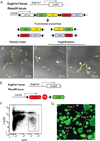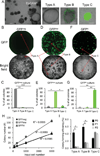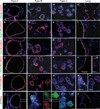Airway epithelial progenitors are region specific and show differential responses to bleomycin-induced lung injury
- PMID: 22696116
- PMCID: PMC4083019
- DOI: 10.1002/stem.1150
Airway epithelial progenitors are region specific and show differential responses to bleomycin-induced lung injury
Abstract
Mechanisms that regulate regional epithelial cell diversity and pathologic remodeling in airways are poorly understood. We hypothesized that regional differences in cell composition and injury-related tissue remodeling result from the type and composition of local progenitors. We used surface markers and the spatial expression pattern of an SFTPC-GFP transgene to subset epithelial progenitors by airway region. Green fluorescent protein (GFP) expression ranged from undetectable to high in a proximal-to-distal gradient. GFP(hi) cells were subdivided by CD24 staining into alveolar (CD24(neg)) and conducting airway (CD24(low)) populations. This allowed for the segregation of three types of progenitors displaying distinct clonal behavior in vitro. GFP(neg) and GFP(low) progenitors both yielded lumen containing colonies but displayed transcriptomes reflective of pseudostratified and distal conducting airways, respectively. CD24(low)GFP(hi) progenitors were present in an overlapping distribution with GFP(low) progenitors in distal airways, yet expressed lower levels of Sox2 and expanded in culture to yield undifferentiated self-renewing progeny. Colony-forming ability was reduced for each progenitor cell type after in vivo bleomycin exposure, but only CD24(low) GFP(hi) progenitors showed robust expansion during tissue remodeling. These data reveal intrinsic differences in the properties of regional progenitors and suggest that their unique responses to tissue damage drive local tissue remodeling.
Copyright © 2012 AlphaMed Press.
Conflict of interest statement
Disclosure Of Potential Conflicts Of Interest
The authors indicate no potential conflicts of interest.
Figures






References
Publication types
MeSH terms
Substances
Grants and funding
- R01 HL060539/HL/NHLBI NIH HHS/United States
- U01 HL099997/HL/NHLBI NIH HHS/United States
- HL090146/HL/NHLBI NIH HHS/United States
- 107633/Wellcome Trust/United Kingdom
- U01 HL100402/HL/NHLBI NIH HHS/United States
- R01 HL090146/HL/NHLBI NIH HHS/United States
- HL064888/HL/NHLBI NIH HHS/United States
- R21 HL089141/HL/NHLBI NIH HHS/United States
- R01 HL064888/HL/NHLBI NIH HHS/United States
- 1U01HL099997-01/HL/NHLBI NIH HHS/United States
- HL089141/HL/NHLBI NIH HHS/United States
- R01 HL090136/HL/NHLBI NIH HHS/United States
- P01 HL108793/HL/NHLBI NIH HHS/United States
LinkOut - more resources
Full Text Sources
Other Literature Sources
Medical
Molecular Biology Databases

